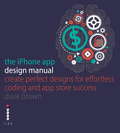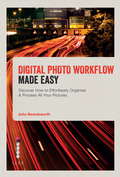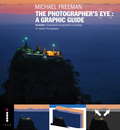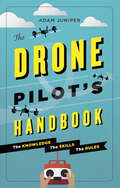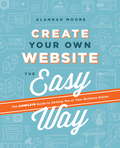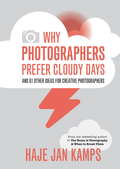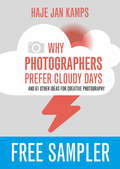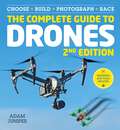- Table View
- List View
The Digital Renaissance: Old-Master Techniques in Painter and Photoshop
by Carlyn BecciaThe Digital Renaissance teaches you how to translate the methods and skills found in traditional art to the digital medium. By covering fundamental painting principles and the basics of digital software, before moving into tutorials that break down key techniques, professional artist Carlyn Beccia encourages you to use the tools at hand to paint your own works of art. Each chapter showcases one great painter - the selection includes Michelangelo, Van Gogh, Sargent, Gustav Klimt, Matisse, and Picasso - and analyses the techniques that set each one apart. These techniques are then emulated in step-by-step tutorials, allowing today's digital artist to achieve amazing results in Corel Painter and Adobe Photoshop.
The iPhone App Design Manual: Create Perfect Designs for Effortless Coding and App Store Success
by Dave Brown Vicky RobertsThe creation of apps for Apple's iPhone is now a huge, and global business, with hundreds of thousands of developers, entrepreneurs and companies attracted by the potential rewards. But games, functional apps and promotional apps alike depend on attractive, intuitive design for their appeal, and most fail to find a significant audience.With this book, you'll be able to turn your great app idea into a functioning design that is ready for coding, or apply graphic design skills to this exciting and lucrative marketplace. You will have a clearly visualised concept and a focused sales plan - and your app will stand out in an App Store that is worth well over a billion pounds every year.
Colour for Web Design: Apply Colour Confidently and Create Successful Websites
by Cameron ChapmanColour is one of the most powerful tools at a designer's disposal, yet few truly understand how much it can do for them, and the immediate difference it will make to the popularity and success of their website.This is the complete guide to creating a unique, practical and appropriate colour palette for any web design project. Building on the basics, starting with essential - often misunderstood - terminology and an understanding of traditional colour palettes, the book then moves on to practical, real-world examples of sites with fantastic colour schemes.A one-stop shop for a complete knowledge of digital colour, this book will give the designer the confidence to create their own palettes and apply colour successfully to their designs.
Social Photography: Make All Your Smartphone Photos One in a Billion
by Daniela BowkerHot photo apps come and go, but the practice of shooting and sharing is universal and is now a fundamental part of the way that we communicate with each other. Photos aren't printed on paper anymore - they are displayed on screens; and everywhere they are shown, the viewer is invited to like or share. Social Photography will show you how to create photos that will be clicked on, liked, shared, and - if you want - go viral. A must-read for anyone who takes their online presence seriously, this book will show you how to give your photos a fresh look, give you hundreds of posing and shooting ideas, and let you share your life's most exciting moments wider than ever before.
The Photographer's Master Guide to Colour
by Jeff WignallWhen every single hue in a photo can be saturated, tinted, cross-processed, filtered, or manipulated using today's wide variety of digital tools, the possibilities are endless - but can also be overwhelming. Expert pro Jeff Wignall demystifies this essential subject in this compelling and richly illustrated guide for photographers who want to master colour and give their images depth and richness. From the origins of colour theory to the latest post-production techniques, the full spectrum is thoroughly covered, with Jeff's own inspirational photography perfectly complementing his authoritative text.Learn when to exercise restraint, and when to boost saturation to the limits. Communicate mood and emotion by learning precisely how human colour perception operates. Make your colours your own, with perfect exposures and dramatic post-production results.Harness the power of colour to push your photos to their full potential!
Digital Photo Workflow Made Easy: Discover How to Effortlessly Organise & Process All Your Pictures
by John BeardsworthDo you know where all your photos are? Can you retrieve every landscape shot or portrait you've ever taken with a few keystrokes and a click of the mouse? Are you looking forward to processing those hundreds or thousands of holiday snapshots? There's no reason why you shouldn't, and this book holds all the answers, and quite a few expert secrets as well.Learn to take advantage of the processes and features of your software of choice to streamline your photo workflow. With advanced methods, tried and tested by an expert photographer, you'll be set on a straightforward path to great, reliable results in no time at all.
The Photographers Eye: Instantly Understand Composition & Design for Better Photography
by Michael FreemanTaking a new look at composition, the theme of his best-selling classic The Photographer's Eye, Michael Freeman now explores the visual mechanics of photography in its own native terms. Lushly illustrated with straight-to-the-point diagrams and graphic deconstructions, this book speaks in that intuitive, visual, and instantaneous language in which photographers think and work. Each section is organised into discrete units that articulate a working method for communicating particular ideas and capturing certain subjects. Dive into beautiful images and explore how each compositional element is placed and arranged in relationship to each other. Examine the outtakes from each shoot to understand why one particular image succeeded, compared to those shot before and after. Track the viewer's eye as it moves throughout the photo to see the optical dynamics held within each frame. And most of all, internalise this graphic language so you can instantly recognise amazing and powerful shots as they appear in your own viewfinder.
The Drone Pilot's Handbook
by Adam JuniperThe perfect companion for anyone buying (or thinking of buying) a drone, whether it's just for fun, to race against friends, or to give their to give their photography a whole new angle.The Drone Pilot's Handbook gives you the skills and techniques you need to fly and maintain your multicopter drone, tips for tuning it for maximum performance, and - importantly - a clear graphical guide to where the law will and won't allow you to fly. Meanwhile, spectacular aerial photography from around the world will inspire you to get airborne immediately!Occasional boxouts provide safety tips, handy ideas, and URLs, and flying instructions are presented with attractive original illustrations. This clean approach that makes a welcome contrast to ugly online forums, or the PDFs that drone manufacturers provide, and will have you up and away in no time.
Create Your Own Website The Easy Way: The No Sweat Guide To Getting You Or Your Business Online
by Alannah MooreEvery small business or organisation needs a website, whether it is a simple online portfolio or a complex online shop. Expert web design teacher Alannah Moore makes this subject accessible for everyone, even those with no technical or design experience. Avoiding technical language, Alannah provides a summary of the web platforms available, covering, among others, WordPress, Squarespace, Weebly and Shopify. From these the reader can choose the right platform for them, and very quickly get up and running.Drawing on her vast experience of what a novice website builder really needs to know, Alannah covers all the topics they will come across in their online experience: how to choose a good domain name; what content you need for your site; how to work with images and even create your own logo. The reader will also learn how to integrate social media and a blog, so they are set up and in control of their virtual presence from every aspect. This is the perfect book for anyone who doesn't want to pay for an expensive web designer. In Alannah's safe and capable hands, they will find the process of building their site easy and enjoyable, and they'll soon have a successful online presence.
The Photographer's Eye Remastered 10th Anniversary: Composition and Design for Better Digital Photographs (The Photographer's Eye #7)
by Michael FreemanWith a completely refreshed look to celebrate its tenth anniversary, Michael Freeman's iconic bestseller, The Photographer's Eye, has never looked better.Design is the single most important factor in creating a successful photograph. The ability to see the potential for a strong picture and then organize the graphic elements into an effective, compelling composition has always been one of the key skills in making photographs. Of course, digital photography has brought a new, exciting aspect to design first because the instant feedback from a digital camera allows immediate appraisal and improvement; and second because image-editing tools make it possible to alter and enhance the design after the shutter has been pressed. This has had a profound effect on the way digital photographers take pictures. The Photographers Eye shows how anyone can develop an eye for seeing great digital photos. The book explores all the traditional approaches to composition and design, but crucially, it also addresses the new digital technique of shooting in the knowledge that a picture will later be edited, manipulated, or montaged to result in a final image that may be very different from the one seen in the viewfinder.
The New Street Photographers Manifesto: Any Camera, Anywhere
by Tanya NagarWhether you shoot with a digital SLR, a Holga or the camera on your phone, today's cameras let you seize the moment and shoot whenever and wherever you like. This makes them perfect for street photography, the genre of choice of some of the greatest photographers of all time, with names like Henri Cartier-Bresson, Weegee and Robert Frank turning gritty reality into iconic images.In this book, Tanya Nagar will open your eyes to the photographic potential of your urban world environment, offering the tricks and techniques that put you in the right place, at the right time, and let you create amazing photos. In addition to everything that'll give you the right skills and headspace to capture great images on the street, Nagar has brought together a stunning showcase of some of the greatest emerging street photographers of our age to inspire you.
The iPad for Artists: How to Make Great Art with the Digital Tablet
by Dani JonesEnabling new and exisiting iPad users to develop and stretch their artistry in the digital age.
If You're Bored With Your Camera Read This Book (If you're ... Read This Book #2)
by Demetrius FordhamYou know photography, don't you? Nice group pictures, tasteful landscapes, perhaps a filter from an app on your phone. Conventional, easy to manage, inoffensive, boring...right?WRONG! In this book you'll find inspiring ideas and genuinely different techniques that you can use to capture anything, from artistic portraits, through to stunning street photography and unusual aboreals. This book will open your eyes, and your lens cap, to new ideas.Topics include:Put Down Your CameraForget the RulesCreative Shooting ExercisesGo Back to Basics
If You're Bored With Your Camera Read This Book (If You're ... Read This Book Ser.)
by Demetrius FordhamYou know photography, don't you? Nice group pictures, tasteful landscapes, perhaps a filter from an app on your phone. Conventional, easy to manage, inoffensive, boring...right?WRONG! In this book you'll find inspiring ideas and genuinely different techniques that you can use to capture anything, from artistic portraits, through to stunning street photography and unusual aboreals. This book will open your eyes, and your lens cap, to new ideas.Topics include:Put Down Your CameraForget the RulesCreative Shooting ExercisesGo Back to Basics
Fashion and Lifestyle Photography: Secrets Of Perfect Fashion And Lifestyle Photography
by Dixie DixonSucceed in the commercial world and become a stand-out fashion & lifestyle photographer. "If you are interested in pursuing fashion and lifestyle photography, this book, from this rising young star of the field, is a must." - Joe McNally Only a few years ago, fashion photography used to be a stuffy world for a tiny elite. Now an explosion in social media and lifestyle advertising has created opportunities for a whole new breed of professional photographer. Fashion and Lifestyle Photography is based on the talks Dixie Dixon, a Nikon Brand Ambassador, has given to crowds at major international trade shows. Expanding on the subject in the book, she reveals how to succeed in this exciting marketplace, covering key topics such as:· Professional case studies· Behind the scenes· Lighting diagrams & gear· How to build your careerFrom finding your vision, to building your dream team, this book will provide you with the essential gear and know-how to capture the looks of the media world that leap off the page or screen."Dixie Dixon is a truly wonderful, vibrant young talent in the field of fashion and lifestyle photography. In this book, she takes you on a lively, complete tour of not only how to make compelling, beautiful photographs, but also how to grow a business, develop a signature look, make your own breaks, gather clients and keep them, use social media well, and assemble a great support team. And that's the short list. This book is full of gems about the seemingly small details that are essential to success." - Joe McNally
Fashion and Lifestyle Photography: Secrets Of Perfect Fashion And Lifestyle Photography
by Dixie DixonSucceed in the commercial world and become a stand-out fashion & lifestyle photographer. "If you are interested in pursuing fashion and lifestyle photography, this book, from this rising young star of the field, is a must." - Joe McNally Only a few years ago, fashion photography used to be a stuffy world for a tiny elite. Now an explosion in social media and lifestyle advertising has created opportunities for a whole new breed of professional photographer. Fashion and Lifestyle Photography is based on the talks Dixie Dixon, a Nikon Brand Ambassador, has given to crowds at major international trade shows. Expanding on the subject in the book, she reveals how to succeed in this exciting marketplace, covering key topics such as:· Professional case studies· Behind the scenes· Lighting diagrams & gear· How to build your careerFrom finding your vision, to building your dream team, this book will provide you with the essential gear and know-how to capture the looks of the media world that leap off the page or screen."Dixie Dixon is a truly wonderful, vibrant young talent in the field of fashion and lifestyle photography. In this book, she takes you on a lively, complete tour of not only how to make compelling, beautiful photographs, but also how to grow a business, develop a signature look, make your own breaks, gather clients and keep them, use social media well, and assemble a great support team. And that's the short list. This book is full of gems about the seemingly small details that are essential to success." - Joe McNally
Why Photographers Prefer Cloudy Days: and 61 Other Ideas for Creative Photography
by Haje Jan KampsThere's no one secret to taking beautiful photos. But good photographers do have a few tricks up theirsleeves... They know that clouds, far from ruining a photo, give a great soft natural light for portraits. They know that unusual angles draw the eye, and that their feet are just as effective as a zoom lens.This book packs 62 of the most important creative ideas into one place. Beautifully presented, easy-to-read and packed with example photos. None of these ideas need an expensive camera, fancy lens or a over-priced flash. The purpose of this book is to help you tell stories with your camera (or phone).Whatever you want to shoot, Why Photographers Prefer Cloudy Days is packed full of ideas to inspire you, and tips that will help you take better, more original photos.
Why Photographers Prefer Cloudy Days: Surprising And Inspiring Tips For Photographers
by Haje Jan KampsThere's no one secret to taking beautiful photos. But good photographers do have a few tricks up theirsleeves... They know that clouds, far from ruining a photo, give a great soft natural light for portraits. They know that unusual angles draw the eye, and that their feet are just as effective as a zoom lens.This book packs 62 of the most important creative ideas into one place. Beautifully presented, easy-to-read and packed with example photos. None of these ideas need an expensive camera, fancy lens or a over-priced flash. The purpose of this book is to help you tell stories with your camera (or phone).Whatever you want to shoot, Why Photographers Prefer Cloudy Days is packed full of ideas to inspire you, and tips that will help you take better, more original photos.
The Beginner's Guide to Photography: Capturing the Moment Every Time, Whatever Camera You Have
by Haje Jan KampsPhotography is a big part of our lives, and we all take photos all the time. By understanding just a few basics of how your camera - or your phone - works, you'll find yourself able to take more exciting, stand-out photos.Within a few pages you'll be able to speak with confidence to photographers about exposure settings, decide what lighting or lenses will lift a scene, or what tactics you can use to make your subject look more interesting.The book also covers the basics of managing, editing & sharing your collection of digital images so you're not at the mercy of the software that was bundled with your phone.
The Photographer's Handbook: Equipment | Technique | Style
by Michael FreemanKnow the equipment, refine your technique and express your style. Combining straightforward guidance with artistic insight, this comprehensive handbook is an essential piece of kit for photographers of every style and experience level. Michael Freeman shows you how to: · Make the most of the gear you have · Master the classic styles & subjects · Compose shots with skill and confidence · Share your work in a meaningful way It's everything you need to be a successful photographer.
The Photographer's Handbook: Be Your Best Photographer (Photographer's Field Guide Ser.)
by Michael FreemanKnow the equipment, refine your technique and express your style. Combining straightforward guidance with artistic insight, this comprehensive handbook is an essential piece of kit for photographers of every style and experience level. Michael Freeman shows you how to: · Make the most of the gear you have · Master the classic styles & subjects · Compose shots with skill and confidence · Share your work in a meaningful way It's everything you need to be a successful photographer.
Why Photographers Prefer Cloudy Days: Surprising And Inspiring Tips For Photographers
by Haje Jan Kamps**FREE SAMPLER** There's no one secret to taking beautiful photos, but good photographers build up a series of useful bits of know-how. They know that clouds, far from ruining a photo, give a great soft natural light for portraits. They know that unusual angles draw the eye, and that their feet are just as effective as a zoom lens.This book packs 62 of the most important creative ideas into one easy-to-read location, beautifully presented with example photos. None of these ideas need an expensive camera, fancy lens or a over-priced flash. The purpose of this book is to help you tell stories with your camera, whatever the camera.Whether you're photographing that perfect sunset or your morning coffee, Why Photographers Prefer Cloudy Days will show you how to capture it to best effect, whether you want it to look great on your Instagram, or amazing on your wall.
The Photographer's Mind Remastered: Creative Thinking for Better Digital Photos (The Photographer's Eye #8)
by Michael FreemanYou've done your research. You've bought your camera. You've learnt how to use it. Now what? The secret behind a good photograph is not your camera. It's not even the scene viewed through the viewfinder. It's the mind of the photographer which turns an average photograph into an exceptional one. In The Photographer's Mind, professional photographer and author Michael Freeman unravels the mystery behind the creation of a photograph and reveals how to capture photos that really make you feel something.The aim of this book is to answer what makes a photograph great, and explore the ways that top photographers achieve this goal time and time again. The Photographer's Mind will provide you with invaluable knowledge on:· Avoiding cliché· The recurring nature of trends· Style and composition· Capturing light· How to handle the unexpected
The Complete Guide to Drones Extended 2nd Edition
by Adam JuniperIf you think you need a boarding pass to fly, you're really missing out... Today, drones are everywhere. From film studios to farms, they're in the hands of photographers, commercial surveyors and racers alike. This fully illustrated book explains how drones developed, where they're going and which one you should choose. It even includes complete instructions to build both a simple drone and a super-fast FPV racer yourself.Whether you're flying indoors or out, buying or building, this book covers everything:¦ Understand the Jargon Flying has a lot of unfamiliar terminology, but this book will make it easy to master.¦ Business or Pleasure Every type of multicopter you might want is introduced, including explanations of which is best suited for what role.¦ Get the Best Pictures This edition includes an extended guide to the tech and composition tricks you can use to make your pictures stand out of the pack.¦ Get the Best Video A new shot-guide shows you how to get the most engaging aerial video, whatever your drone.¦ Be a Winning FPV Racer There are two complete step-by-step instructions for building your own drones inside: an FPV racer, or a surprisingly cheap wooden drone - both great projects.Following the worldwide success of the first edition, which has been translated into numerous languages, this second edition is not only fully updated to keep pace with the laws and technology, but also extended to thoroughly cover the fast-growing new sport of FPV drone racing, while still including a comprehensive guide to learning to fly any drone.
The Complete Guide to Drones Extended 2nd Edition
by Adam JuniperIf you think you need a boarding pass to fly, you're really missing out... Today, drones are everywhere. From film studios to farms, they're in the hands of photographers, commercial surveyors and racers alike. This fully illustrated book explains how drones developed, where they're going and which one you should choose. It even includes complete instructions to build both a simple drone and a super-fast FPV racer yourself.Whether you're flying indoors or out, buying or building, this book covers everything:¦ Understand the Jargon Flying has a lot of unfamiliar terminology, but this book will make it easy to master.¦ Business or Pleasure Every type of multicopter you might want is introduced, including explanations of which is best suited for what role.¦ Get the Best Pictures This edition includes an extended guide to the tech and composition tricks you can use to make your pictures stand out of the pack.¦ Get the Best Video A new shot-guide shows you how to get the most engaging aerial video, whatever your drone.¦ Be a Winning FPV Racer There are two complete step-by-step instructions for building your own drones inside: an FPV racer, or a surprisingly cheap wooden drone - both great projects.Following the worldwide success of the first edition, which has been translated into numerous languages, this second edition is not only fully updated to keep pace with the laws and technology, but also extended to thoroughly cover the fast-growing new sport of FPV drone racing, while still including a comprehensive guide to learning to fly any drone.

